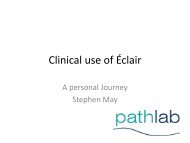to read the full article - Sysmex New Zealand
to read the full article - Sysmex New Zealand
to read the full article - Sysmex New Zealand
Create successful ePaper yourself
Turn your PDF publications into a flip-book with our unique Google optimized e-Paper software.
| management<br />
Taking <strong>the</strong> ouch out of healthcare-acquired<br />
infections<br />
Infections contracted in health care systems are a significant problem, affecting over<br />
1.4 million people worldwide and up <strong>to</strong> 10 percent of patients admitted <strong>to</strong> modern<br />
hospitals in <strong>the</strong> developed world. In 2003 <strong>the</strong> estimated annual cost <strong>to</strong> DHBs of<br />
treating hospital-acquired infections (HAI) was approximately $140 million. This<br />
does not of course take in<strong>to</strong> account <strong>the</strong> impact on <strong>the</strong> individual patients. Recent<br />
estimates in Australia put <strong>the</strong> cost of HAI at $1 billion per annum and $5-10<br />
billion in <strong>the</strong> US. 1,2<br />
A systematic method of collecting, collating and analysing data concerning <strong>the</strong><br />
distribution and features of a disease or organism is an essential component for an<br />
effective infection prevention and control programme.<br />
For UK’s Imperial College Healthcare NHS Trust <strong>the</strong> process has been<br />
greatly assisted following <strong>the</strong> adoption of ICNet in December 2006. Nearly<br />
three years on and <strong>the</strong> Trust, which with five hospitals in west London, 1900<br />
general, acute specialist and private beds and 9146 staff is <strong>the</strong> largest in <strong>the</strong><br />
UK, has avoided any significant outbreaks of healthcare acquired infection,<br />
despite increases of diseases such as norovirus and influenza.<br />
ICNet is an innovative software package that allows real time collaboration<br />
of patient and labora<strong>to</strong>ry data <strong>to</strong> enable proactive infection control case<br />
management and surveillance of HAI. ICNet also provides a powerful <strong>to</strong>ol<br />
for <strong>the</strong> manipulation and analysis required for manda<strong>to</strong>ry reporting of <strong>the</strong>se<br />
infections.<br />
Clare Johns<strong>to</strong>ne, an Infection Prevention and Control Nurse at <strong>the</strong> Imperial<br />
College Healthcare NHS Trust, spoke <strong>to</strong> Infection Control Nurses (ICNs)<br />
at a recent national conference in Nelson. Among her key points, getting<br />
<strong>the</strong> Infection Control Nurse back <strong>to</strong> <strong>the</strong> point of care is key <strong>to</strong> successful<br />
infection control, and ICNet has enabled that. The following is an adaptation<br />
of Miss Johns<strong>to</strong>ne’s presentation.<br />
“What we are talking about is surveillance for <strong>the</strong> patient; surveillance and<br />
case management. With <strong>the</strong> right information, action and interventions, you<br />
ultimately improve patient safety.<br />
“In <strong>the</strong> past we had daily listings from <strong>the</strong> labora<strong>to</strong>ry systems, which <strong>to</strong>ok<br />
hours <strong>to</strong> interpret and document. Records were paper-based, <strong>the</strong>re were<br />
delays in informing clinical staff, and it was difficult and time-consuming <strong>to</strong><br />
identify and manage outbreaks. Audit trails were also time-consuming <strong>to</strong><br />
document and assess.<br />
“Infection Control Nurses would spend hours in <strong>the</strong> office, communicating<br />
with wards mainly by telephone or brief visit. Minimal time was spent with<br />
patients or in providing education.<br />
“In recognition of <strong>the</strong> challenges this approach posed nationally, <strong>the</strong><br />
Department of Health and Health Protection Agency in <strong>the</strong> UK piloted three<br />
infection control software systems. We developed a business case for <strong>the</strong><br />
ICNet option, which offered a case management facility as well as <strong>the</strong> ability<br />
<strong>to</strong> produce quick and early reports.<br />
“The pilot and interaction with o<strong>the</strong>r ICNet users provided <strong>the</strong> ground work<br />
for much of <strong>the</strong> implementation, which involved <strong>the</strong> development of interfaces<br />
with our labora<strong>to</strong>ry system, <strong>the</strong> creation of a list of alert organisms and <strong>the</strong>ir<br />
link <strong>to</strong> KPIs, training and testing. We went live in December 2006.<br />
“ICNet provided training, which included in-depth training that enabled me<br />
<strong>to</strong> become <strong>the</strong> Trust’s in-house ICNet trainer. Everyone was very supportive<br />
of <strong>the</strong> new initiative and could see <strong>the</strong> benefits.<br />
“We now have a system for infection control that has a live interface<br />
with labora<strong>to</strong>ry and patient<br />
administration systems via a single<br />
patient record.<br />
“We set it up so we have three regular<br />
downloads from <strong>the</strong> labora<strong>to</strong>ry each<br />
day. This creates an even sp<strong>read</strong><br />
throughout <strong>the</strong> day creates a more<br />
manageable caseload.<br />
“The information is accessible through<br />
our web-based internal access via<br />
software in <strong>the</strong> wards as well as<br />
tablet PCs. Organism, specimen<br />
and antibiogram information is<br />
at <strong>the</strong> ICN’s fingertips and expert<br />
advice for clinicians and nurses is<br />
au<strong>to</strong>matically documented.<br />
“Because <strong>the</strong> information is instant,<br />
we are able <strong>to</strong> quantify IP&C case<br />
loads, document workload and<br />
configure alerts in real time. ICNet<br />
also gives us <strong>the</strong> ability <strong>to</strong> tag patient<br />
records so <strong>the</strong>y are immediately<br />
visible when re-admitted, <strong>the</strong>reby<br />
reducing cross-infection. An<br />
assurance audit trail is generated<br />
and manda<strong>to</strong>ry reporting is almost<br />
instant.<br />
“ICNet has resulted in 15 hours<br />
per week of ICN time being freed<br />
up per site. This has in turn led<br />
<strong>to</strong> an increase in direct patient<br />
contact and increased education<br />
at ward level. As a consequence<br />
we are experiencing a reduction<br />
in ward outbreaks, with speedy<br />
interventions preventing relapses<br />
and cross infections.<br />
“In <strong>the</strong> future we intend <strong>to</strong> link ICNet<br />
<strong>to</strong> <strong>the</strong> operating <strong>the</strong>atre database<br />
<strong>to</strong> expand and improve surgical<br />
site infection moni<strong>to</strong>ring. We also<br />
hope <strong>to</strong> connect it <strong>to</strong> a proposed<br />
electronic prescribing system <strong>to</strong><br />
review and audit antibiotic usage<br />
and promote first class antibiotic<br />
stewardship.<br />
“We have found ICNet <strong>to</strong> be a very<br />
easy system <strong>to</strong> use with major<br />
benefits in having a single record<br />
and single documentation. We can<br />
now focus on case management,<br />
education and assuring patient<br />
safety.”<br />
This talk promoted much discussion<br />
within <strong>the</strong> ICN community at <strong>the</strong><br />
Nelson Conference and more details<br />
on it can be found at www.sysmex.<br />
co.nz and www.icnetplc.com<br />
July - August 2009 | <strong>New</strong> <strong>Zealand</strong> Health & Hospital | 15 |
ICNet au<strong>to</strong>mates <strong>the</strong><br />
collection of labora<strong>to</strong>ry<br />
results, surgical and<br />
patient admission details<br />
in<strong>to</strong> its browser-based<br />
display. This gives<br />
Infection Control Teams<br />
a patient-centric view of<br />
all <strong>the</strong> information.<br />
With real-time alerts<br />
and a wide range of<br />
reporting and analytical<br />
<strong>to</strong>ols, ICNet saves time<br />
and promotes quicker,<br />
more targeted responses.<br />
It has been proven <strong>to</strong><br />
significantly reduce <strong>the</strong><br />
incidence of healthcare<br />
acquired infection.<br />
ICNet is available in <strong>New</strong><br />
<strong>Zealand</strong> through <strong>Sysmex</strong><br />
<strong>New</strong> <strong>Zealand</strong> Ltd.<br />
References<br />
1. 1.Medical <strong>New</strong>s <strong>article</strong> - http://www.news-medical.<br />
net/news/20090903/Healthcare-acquired-infectioncosts-241-billion-per-annum.aspx<br />
2. Cost of Healthcare-associated infections (HAI) and<br />
Hospital Budgets for InfectionControl and Prevention<br />
(IC): Just a Drop in <strong>the</strong> Ocean - https://dicon.<br />
mc.duke.edu/wysiwyg/downloads/HAI_cost_<br />
abstract-shea_FINAL_by_Dev.pdf<br />
| 16 | <strong>New</strong> <strong>Zealand</strong> Health & Hospital | July - August 2009
















